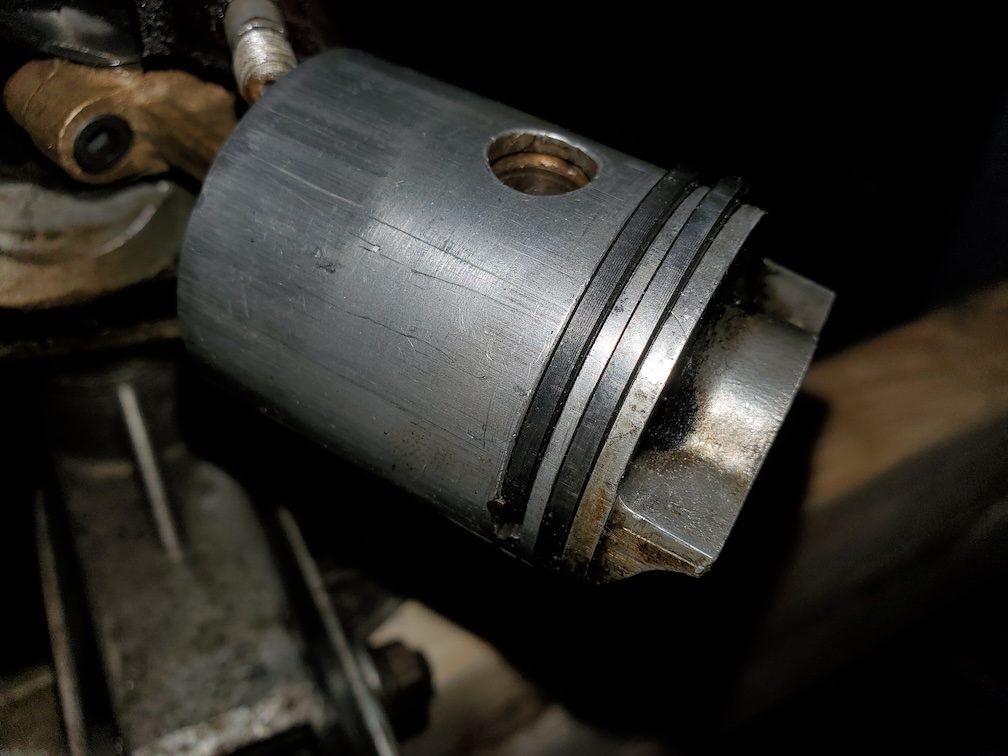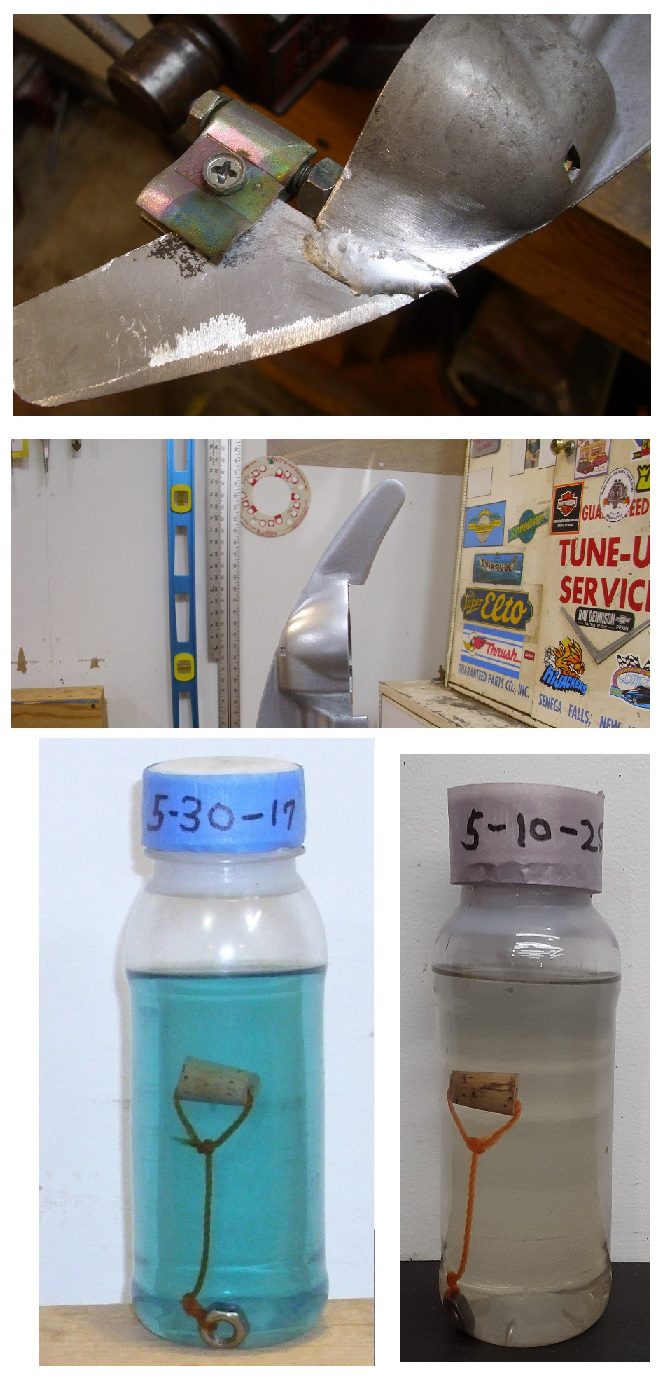Home › Forum › Ask A Member › Neptune magneto question(s)
- This topic has 26 replies, 6 voices, and was last updated 6 months, 4 weeks ago by
 tibor.
tibor.
-
AuthorPosts
-
May 11, 2025 at 4:03 pm #296354
I went back to check on compression as the first readings were not too great. Now after things loosed up, I still only get slightly over 40 psi. Is that acceptable? I would imagine we’d want to see values in the 60s.
Took the power head apart, one one of them I just cannot get the wrench to the bottom two nuts holding the cylinder. What do people do with these? You need to grind down some of the wrenches?
Anyway, the 15A1 I could take apart, the inside of the cylinder does not look too bad, the two rings also look ok. It looks like that these are 40 mm x 2 mm rings, are they still available?
May 13, 2025 at 1:41 pm #296400Could someone please double check this?
I took the head and the cylinder off, it looks like that from the ports to the top of the cylinder it’s 28 mm. The diameter of the cylinder is around 39 mm. So that is a volume of ~33.5 cm3. (The piston is pretty much flush with the end of the cylinder at tdc.)
I measured the volume of the head by the sophisticated method of pouring water into it and measuring the weight of the water (at 1 g / cm3), came out 13 g = 13 cm3.
So head + cylinder is 46.5 cm3 (2.84 cubic inches, matches the spec of 2.87 pretty well), the head is 13 cm3, that means the max theoretical compression ratio of 3.57. 1 atm = 14.7 psi, so I guess in theory one could not see compression higher than 52. So I guess my numbers were not that bad at all.
May 13, 2025 at 10:05 pm #296413
To check the ware of the rings, and the cylinder, remove one ring. Place it in the bottom of the cylinder, below where it runs. Get the ring square in the cylinder. A piston skirt is often used but anything true, that just fits to straighten the ring will do. A machinist rule or caliper will also work. I’m sure you can find a way to get it done. The end gap, when new, should be around .006 to .008 for a 1.5 inch bore. Then move the ring to the top of its travel. That difference in the end gap, from bottom to top, is (roughly) how much taper you have in the cylinder. 3 or 4 thousands should be expected. 10, 11, 12, thousands or more will result in a significant loss of compression.
A "Boathouse Repair" is one thats done without having tools or the skills to do it properly.
May 14, 2025 at 7:22 pm #296438Tubs, thank you very much for the advice! In general for a small 2 stoke how much loss in practical pressure compared to theoretical compression is expected?
So if I have an engine with compression ratio of 10, and I measure 117 psi (80%, compared to 10 * 14.7) am I happy or am I sad?
May 14, 2025 at 10:31 pm #296442
First I’m not criticizing your approach. If your enjoying this endeavor, that what its all about. Equations and theories are far above my IQ level. I have to deal with results. My method is to inspect and clean the gear case, fuel system, and ignition, checking for spark. If there are no obvious issues, I try to start the motor. If I cant get one to run, then I get out the ignition tester, compression gauge, multimeter, exct. and try to discover the issue. I don’t disassemble the power head until I’m convinced that is the problem. The parts aren’t available to correctly rebuild one, and as the rings are seated, I feel its best not to disturb them. This is not to say you have made a mistake, its just what works for me. I can tell you that because of the fuel at the time your motor was new, the compression ratio’s in most motors were rarely more than 6 to 1.
A "Boathouse Repair" is one thats done without having tools or the skills to do it properly.
1 user thanked author for this post.
May 15, 2025 at 6:29 am #296443Tubs, thanks for you comment, I understand. For me these two old engines are more of a curiosity project than anything else. They did not work when I bought the pair for $50 and I figured that worst case I clean them up, paint them and they will look fantastic as decoration pieces …. for anyone who wants a small outboard on their wall 🙂
So when I watch youtube videos in which people say “you have to have 60+ psi for a small outboard for it to run” I cannot get away from the “Is that true?” and “Why?” questions, that’s how I end up measuring water out of the head on the kitchen scale.
Speaking of parts that are not available, both motors have their skeg broken off … it must be some sort of weak point as most pictures I see of these Neptunes have them missing. Is it something that can be made at home and TIG welded back together? Are these gear boxes even aluminum? I think I could cut something reasonable looking out of a flat aluminum piece.
May 15, 2025 at 6:42 am #296445Since I had them apart, scanned the head gaskets too, traced them, so if anyone needs to make a new one, here are the drawings. (I also have the vector ones.)
May 15, 2025 at 11:21 am #296453
Your motor is mostly aluminum. Its common for the skeg to be broken off on the smaller motors. It cant take being use as a stand, but when you’re getting in to position to put the motor on the boat, or in the car, or opening the garage door, most everyone sets the motor down on the skeg. Usually the aluminum after WW-II can be mig or tig welded. There is also an aluminum brazing rod that I have used to replace skegs. I have a box of scrap aluminum parts that I can usually find something to make one out of. I have been struggling with this stuff for over 25 years and I’m finely having acceptable results. I have a vague memory of telling someone about this stuff. I have a clear recollection of him getting back to me, thanking me for telling him about it, and how easy he thought it was to use!!!!! I’m 79. At some point in my life it became apparent to me that if I want to know if something is true I needed to test it for my self. They say you have to coat a cork float. I don’t. I put this cork in a bottle of gas in 2017. I change the fuel from time to time. Gas with oil, ethanol with oil. Just a few days ago it was getting low do to evaporation so I put in gas only this time. They say you have to use a redickuless amount of oil. I don’t. Here is a link to my play list. All these motors (except the 1/2 hp Cub) are running on 3 oz. of oil per. gal. https://www.youtube.com/watch?v=l1ext_nsrYM&list=PLEJogujM4_caTskpk39oQDt49r-qowimV These are NOT reconditions. Just my experience. I rarely check compression other than to pull a motor over unless it wont run or isn’t running properly. I think that the answers you seek can be found out in your shop.
A "Boathouse Repair" is one thats done without having tools or the skills to do it properly.
2 users thanked author for this post.
May 15, 2025 at 8:39 pm #296471Tubs, amazing, thank you very much for all the info. Your channel is great, I can totally see how the dual Eltos in the 1930s developed into the quad Mercury 500s of today 🙂
I will totally try brazing aluminum and if I can make a joint, I will be making new skegs. Yours looks absolutely great!
May 15, 2025 at 8:59 pm #296472Tubs, just watched the coil replacement video where you file down the laminated core. Revolutionary! One of my Neptunes has the same thing, the core is just a bit too big for the “standard” replacement coil. Luckily my coil still looks and measures good (after 80 years) but I would not have dreamt of filing down the laminate to fit a new coil on it.
Thank you, now I will continue watching all your videos 🙂
-
AuthorPosts
- You must be logged in to reply to this topic.



